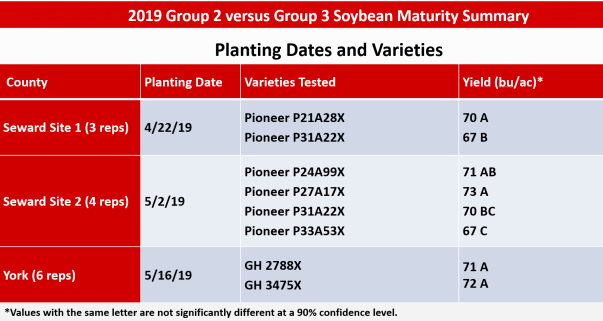Upcoming Events:
Mar. 2: On-Farm Research Brainstorming meeting, 9 a.m.-Noon, 4-H Bldg, York. RSVP: jrees2@unl.edu
Mar. 2: Annie’s Inspired Workshop for Women: Mental Health, Stress, Leadership, Civic Center, Seward, RSVP: 402-367-7410 or 402-362-5508
Mar. 3: Southeast Nebraska Soil Health Conference, Auditorium, Hickman
Mar. 3: Windbreak Renovation Workshop, 9 a.m., Extension Office, Seward
Mar 3: Pesticide Training, 9 am, Grand Island, Hall Co Extension OfficeMar 3: Chemigation Training, 1 pm, Grand Island, Hall Co Extension Office
Mar 3: Pesticide Training, 2 pm, Lawrence, Dick’s Place
Mar. 4: Arrow Seed Soil Health Conference, 10 am-4 p.m., Convention Center, Broken Bow, 308-872-6826
Mar 5: Pesticide Training, 9 am, Friend, Catholic Church
Mar 5: Dicamba Training, 10 am, Central City, FairgroundsMar 5: Pesticide Training, 1 & 6pm, David City, Event CenterMar 5: Pesticide Training, 1:30 & 6:30 pm, Central City Fairgrounds
Mar 9: Pesticide Training, 6 pm, Lincoln, Extension Office
Mar 10: Pesticide Training, 9 am, Lincoln, Extension Office
Mar 10: Pesticide Training, 9 am & 6 pm, Clay Center, Fairgrounds
Mar 10: Pesticide Training, 9 am & 1 pm, Osceola, Fairgrounds
Mar. 10: Farmers/Ranchers College “Strategies for Family Farming Success in the Shark Tank”, 6 p.m. (Reg. 5:30), Fairgrounds in Geneva
Mar 10: Pesticide Training, 6 pm, Wilber, Extension Office
Mar. 11: Crop Scout Training for Pest Managers, ENREC (former ARDC near Mead)
Mar. 14: Intro. to Beekeeping Workshop, Raising Nebraska, Grand Island,
Mar. 16: Kiwanis Ag Banquet, Fairgrounds, Seward
Mar. 16: Annie’s Inspired Workshop: Crop Scouting, 6-8 p.m., 4-H Bldg, York, RSVP: 402-367-7410 or 402-362-5508
Mar. 19: Chemigation Training, 1:30 pm, Fairgrounds, Holdrege
Mar. 26: Chemigation Training, 1:30 p.m., Extension Office, Kearney
Mar. 30: CSI for youth, 5-6 p.m., jrees2@unl.edu
Mar 31: Dicamba Training, 5 pm, Hastings, Adams Co Extension Office
Happy March! One question that’s surfaced often is ‘at what maturity of corn and soybean do we start losing yield?’ There are many reasons for this question including planting a range of maturities to spread harvest load, taking advantage of marketing opportunities, and even planting shorter maturities to allow for increased cover crop biomass after harvest. The past two years, on-farm research growers in York and Seward Counties have compared Group 2 vs. Group 3 beans planted early to determine any yield differences. In 2018, combining the data from 16 reps over 3 locations planted the first week of May, the Group 2 and Group 3 beans yielded 70.2 bu/ac vs. 71.5 bu/ac respectively with no yield difference. In 2019, there were 13 reps over 3 locations. We don’t have these analyzed as a group. At the first (non-irrigated) location planted April 22, the 2.1 bean significantly out-yielded the 3.1 bean (70 bu/ac vs. 67 bu/ac). At the second (irrigated) location planted May 2, the 2.4 and 2.7 beans significantly out-yielded the 3.1 and 3.3 beans (71, 73, 70, and 67 bu/ac respectively). At the third (irrigated) location planted May 16, there was no difference between the 2.7 and 3.4 beans (71 vs. 72 bu/ac respectively).
Small plot research containing 16 soybean varieties with 8 relative maturities (range from 0.3 to 4.7) in Nebraska, Ohio, and Kentucky showed that soybean yields leveled off with no differences between Group 3 and Group 4 beans. They found a 3-4 bu/ac difference between Group 2 and 3 beans across locations. Ultimately, from looking at a variety of research studies including our on-farm research studies, we would suggest that when comparing really high yielding genetics of Group 2 vs. Group 3 beans, there aren’t yield differences. The small plot research also showed that there was an 11-13 day difference between R8 (full maturity) occurring in soybean from Group 3 to Group 4 and a 10 day difference between Group 2 to Group 3 occurrence of R8. What this suggests is for those seeking to plant Group 2 beans to get cover crop biomass established after harvest, one can gain an additional 10 days by following the drill behind the combine compared to planting a Group 3 bean and an additional 20 days compared to a Group 4 bean. It’s estimated every 0.1 in maturity results in 1 day harvest difference. Looking at our on-farm research data in York and Seward, for the grower who harvested the different maturities based on 13% moisture, the harvest date difference between his Group 2 vs. Group 3 beans lined up pretty well with that line of thinking.
For corn, relative maturities of 95, 105, 111, and 113 days were planted in 2017 in two locations. That year showed no yield difference for the 105-113 day but it dropped off for the 95 day. In 2018, relative maturities of 95, 99, 105, 111, and 113 were compared at one location. The yield trend showed the 113 day yielding significantly higher than 111 and 105 with the 95 and 99 day yielding the least. Based on that data and data from UNL’s South Central Ag Lab (SCAL), a 105 day relative maturity appears to be the cut off before seeing significant yield loss., but corn yields vs. maturity are highly dependent on hybrid and growing season. Greatest fall and spring cover crop biomass at SCAL planted after corn harvest (2015-2016) occurred after harvesting 88-105 day relative maturities.
Kiwanis Club of Seward 52nd Ag Recognition Banquet will be held March 16 at the Ag Pavilion at the Seward County Fairgrounds. The evening social begins at 5:30 p.m. with wine by James Arthur Vineyard and cheese from Jisa’s Farmstead Cheese. At 6:30 p.m. will be the prime rib dinner. Greg Peterson of the Peterson Brothers (YouTube celebrities) will be the evening entertainment. Honored as the Seward Kiwanis Outstanding Farm Family of the Year is Tomes Family Farm (Bill, Patty, Andrew, and Becky). Honored as the Seward County Agribusiness of the Year is the Lawrence and Della Beckler Family (Richard, Ruth and Kris Beckler). To purchase tickets, please call Shelly at (402) 643-3636.





































